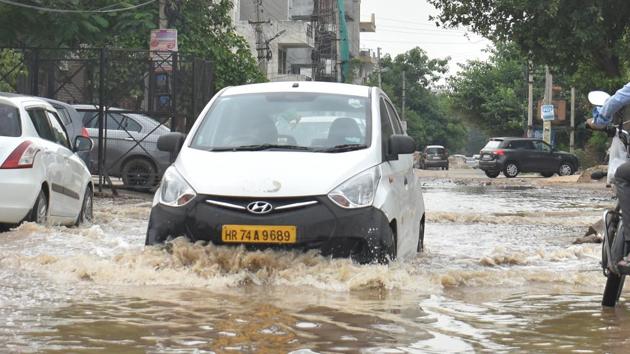What’s flooding Gurugram apart from rains?
Ignoring a city’s topography, excessive concretisation, and lack of resilient infrastructure are some of the reasons why residents in Gurugram suffer during the monsoon season.
Last week, as the rains brought the Millennium City to a grinding halt, the city had been trending on the social media with the notorious ‘Gurujam’ hashtag -- referring to the 20-hour traffic jam on Delhi-Gurgaon Expressway in July 2016. Even though the situation did not turn out to be so bad as 2016, the rains exposed how ill-prepared the city still is and the fact that it is yet to learn its lesson.

The authorities, mostly the police, did come out in on the streets to manage traffic in the heavy downpour, but the severe waterlogging brought back in sharp focus the problem of urban flooding becoming an annual ritual.
Ironically, as Gurugram and several other cities struggle to cope with the monsoon, they are simultaneously facing a severe water crisis.
According to a NITI Aayog report, 21 Indian cities are expected to run out of groundwater by 2020. It is also an open secret that Gurugram is facing a huge water crisis and many parts of the city don’t even get the basic water supply in summers. The question, therefore, is why is there such a disparity and can the cities do a better job of addressing these issues? I surely think so, and let me explain how.
1. Ignoring a city’s topography: Most of the planning in our cities is done without taking into account the natural topography, which means that the undulation and natural drainage systems, etc, are not considered or flattened to maximise the area which can be developed. This same infrastructure then blocks the natural drainage systems, triggering waterlogging even after moderate rains. Therefore, it is important that in the urban planning schemes new sectors of a city are built after considering a detailed drainage plan that heeds and preserves topographical conditions of the area and the natural drainage.
2. Unending love for concrete: It is unfortunate that for most people in an urban setting, the solution to any problem is more construction, this means adding more building material such as concrete, bitumen, steel and cement, to our environment. This approach is not only incorrect, but in many cases this aggravates the problem. Gurugram has seen time and again that right from roads to drains to public spaces, parks and playgrounds, concretisation is seen as a fix for all problems; in many cases even rows of plants and trees are concretised.
The result of this blind concretisation is that the earth can’t absorb water. With the surface encroached and drains blocked, the water stands stagnant for hours and days. Waterlogging was not a problem in Gurugram till it entered this millennium because the land was porous and free of concrete. Therefore, it is important for the city to have permeable spaces, which can easily be done by replacing concrete in some places with turfing and using interlocking tiles.
3. Missing resilient infrastructure: There is growing evidence from the climate change advocates that the change in atmospheric conditions have and will continue to result in extreme weather events. While climate change is a complex subject that is being debated and addressed at international levels, its effects are crippling our cities specially during rains. Therefore, it is important for cities to plan resilience infrastructure and preserve their environment.
For example, a slight downpour causes failure of traffic signals in Gurugram. But the city can overcome this by investing in all-weather signals. Yes, they will be costly, but their impact is also very high. Similarly, innovations like porous bitumen should also be tested, especially in parking areas.
We need to realise that we are living in a world where the unexpected will happen and extreme weather condition will reoccur, be it natural or man-made. Therefore, the city should be ready on two counts—planning and preparation. First, the planning should be such that it does not make us slaves of our mistakes. Second, even during extreme weather conditions, the city should be thoroughly prepared. A lot can be done around the content of this preparedness i.e. right planning, coordination and execution. But, we should also look at the process of this preparedness.
While Gurugram should improve on the routine preparations such as de-silting and cleaning of drains, the city planners need to think beyond the routine. Gurgaon may have been rebranded Gurugram for good, but “Gurujam” is surely not a moniker it would like to earn.
(Amit Bhatt is Director — Integrated transport, WRI India)
Stay updated with all the Breaking News and Latest News from Mumbai. Click here for comprehensive coverage of top Cities including Bengaluru, Delhi, Hyderabad, and more across India along with Stay informed on the latest happenings in World News.
Stay updated with all the Breaking News and Latest News from Mumbai. Click here for comprehensive coverage of top Cities including Bengaluru, Delhi, Hyderabad, and more across India along with Stay informed on the latest happenings in World News.






